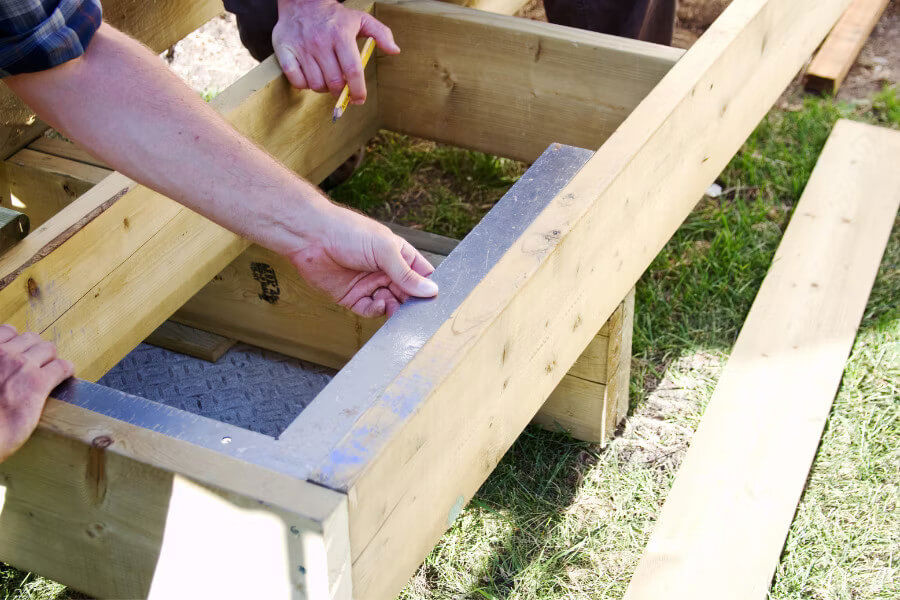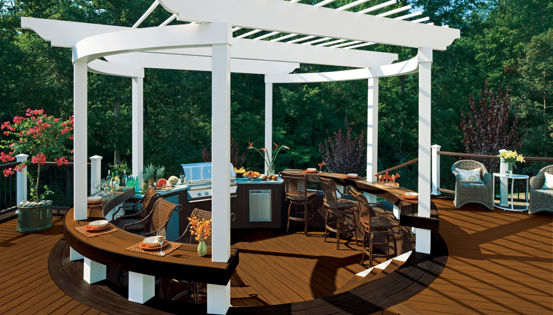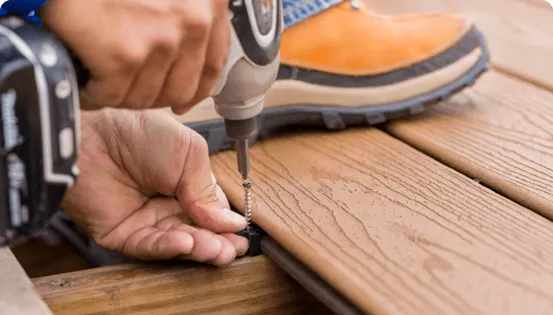You’ve postponed your weekend plans to square your deck, but as the week dwindles, reality hits. You’re unsure where to begin, what numbers to crunch, and why a square deck is important.
The good news is that squaring a deck isn’t as overwhelming as you might think. The process doesn’t require expensive or specialized tools and is equally suitable for seasoned DIY enthusiasts and first-timers. This guide explores four tried and true methods to ensure your deck frame is perfectly square for safety, durability, and aesthetics.
Is it Important to Have a Squared Deck Frame?
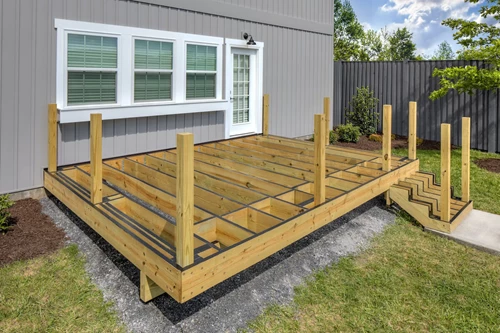
While there may be some exceptions, such as irregularly shaped decks, a square deck is essential in most cases. A squared deck frame is visually pleasing and vital to your deck's overall durability and safety.
Additionally, building codes address the squareness of a deck when auditing a structure. Not knowing how to square a deck can result in one or more of these potential consequences:
- Unprofessional appearance: Deck boards don’t line up properly on a deck that isn’t square, resulting in poor aesthetics.
- Shortened lifespan: Connections and joints that aren’t square can weaken over time, causing an unstable deck that’s more prone to fail.
- Limited adjustments: A non-square deck can increase the complexity and cost of adding new railings, stairs, or pergolas to an existing structure.
- Slower install: Building around non-square deck components can be time-consuming and frustrating. The additional effort required can extend the construction timeline and exceed the budget.
- Low resale value: A poorly squared deck can reduce the resale value of a home, deterring potential buyers.
Obviously, the more square the frame, the better. Slight tolerances can be adjusted before the joists are installed to prevent exaggeration.
Make Sure Your Deck Posts are Square Before You Try to Square Your Deck Frame
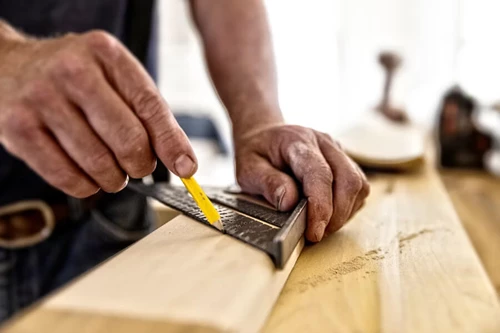
Deck posts are the vertical support pillars that hold up your deck. They work in tandem with the frame to create a stable and safe outdoor space. If you’re unsure of how to square a deck post, it creates a domino effect that can make the entire structure vulnerable to a slew of issues, including:
- An uneven deck surface
- Weakened structural integrity
- Safety concerns
- Difficulty attaching railings, stairs, and other features
Your deck frame can only be as square as the posts that support it. To set your deck up for squared success, learn how to install wood deck support posts before starting your decking project.
4 Best Ways to Square Up a Deck
Knowing how to square decking frames is key if you want a deck that will remain safe and stable for years to come. The following four techniques can help you achieve a perfectly squared deck with minimal resources, ensuring your deck project succeeds.
To get the full guide on layout your deck frame, dive into this Trex Academy video tutorial.
3-4-5 or 6-8-10 Method
The 3-4-5 method relies on the Pythagorean theorem and follows these simple steps:
- Choose a corner of your deck frame to begin.
- From the corner, measure out 3 feet along one edge and mark it.
- Next, measure 4 feet along the edge adjacent to the first measurement and mark it.
- Measure the length of the diagonal connecting the two marked points. If it's exactly 5 feet, your corner is square.
One of the key advantages of the 3-4-5 method is its reliability across any symmetrical shape. Whether it’s rectangular, square, or even an irregular shape, squaring a deck with the 3-4-5 method works.
However, some builders prefer the 6-8-10 method for larger decks or when higher precision is required. The larger measurements reduce the potential for errors.
If you decide this method is best for you, keep these tips in mind:
- Use chalk lines, a combination square, or painter's tape to mark the points where you'll measure clearly. Creating a visual guide helps prevent mistakes.
- Invest in accurate measuring tools to minimize errors.
- After applying the 3-4-5 or 6-8-10 method, double-check your deck frame's squareness by measuring the diagonals in both directions.
You can also use the 3-4-5 rule to verify right angles.
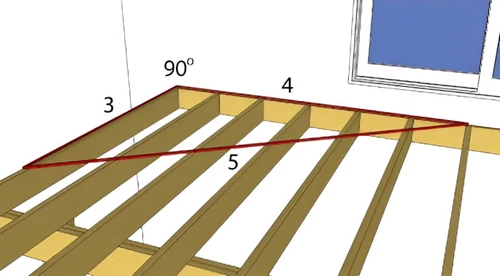
Measure Corner to Corner
Compared to the 3-4-5 method, the corner-to-corner method is less complex. Here's how to use it:
- Choose any corner of your deck frame as your starting point.
- Measure diagonally to the opposite corner of your deck frame.
- Repeat the measurement from a different starting corner to its opposite corner.
- If both diagonal measurements are equal, your deck frame is square.
The corner-to-corner method’s primary advantage is simplicity. You don't need special calculations or ratios to square up a deck. For a fool-proof approach, use an accurate measuring tape in good condition. Make sure you’re measuring opposite corners, adjusting the frame as needed.
Once the perimeter boards are in place, you can “square” the deck using two tape measures. In the case of a square or a rectangle, you will measure diagonally from corner to corner on both sides. These measurements should be equal.
String Method
This method is best for floating decks, where a ledger board can’t be used as a reference. It relies on batter boards to form an L-shape that mimics each corner of your deck. Here’s how to square a deck with string:
- Outline where your deck will be using batter boards as anchors.
- Tie strings to the batter boards, positioning them along the outer edges of your beams. Create two more parallel strings to outline the opposite edges of the beams.
- Use the 3-4-5 method to ensure the first set of strings is square and establish a right angle.
- Once you've confirmed that all the strings are square, install your rim joists along the inside edge of the strings to help frame the deck accurately.
The string method ensures precise measurement and leveling for free-standing structures, giving it an advantage over other methods designed for different types of deck designs.
To make the most of this method, ensure the batter boards are stable and well-anchored for accuracy. You can also periodically measure your diagonals to confirm that your deck frame remains square as you work.
Framing Square and 4’ Level
For those who prefer a tool-based approach to square-up decking frames, the combination of a framing square and a 4' level is an excellent choice. Here's how to use the framing square and 4' level method:
- Place the framing square into one corner of your deck frame, ensuring it sits perfectly flush with both sides.
- With the framing square in place, use a 4' level to check if the square is perfectly level. Adjust as needed until the level indicates that it's level in both directions.
- Repeat this process for all corners of your deck frame.
This method is highly accurate, leaving little room for error as it uses specific square measurement tools most other methods don’t include.
For best results, ensure your framing square and 4' level are in good working order and not damaged. When measuring, secure the framing square to prevent any movement that may throw off your numbers.
Using a square and a 4’ level will also help verify that your deck form is level.
Keeping a Frame Square as You Add the Joists
Joists are the horizontal beams that provide support to your deck. To maintain the structural integrity and squareness of your deck as you add them, follow these steps:
- Start by cutting your joists to the correct lengths that match the squared-up measurements of your deck frame. Ensure that each joist fits snugly between the frame's corners.
- While attaching the joists to the frame, employ temporary diagonal braces, such as 2x4 boards, as support.
- Regularly check your measurements and diagonals as you progress, ensuring that any minor yet necessary adjustments are made promptly.
Remember that your entire deck's overall stability and appearance rely on keeping the frame square as you add the joists. By keeping your guard up and tape measure out, you'll be on your way to building a sturdy, safe, and aesthetically pleasing deck.
As the joists are added, they should not only add strength and rigidity but should also, in effect, square your deck if they are cut to the appropriate lengths. Compare the opposite lengths of the perimeter of squares and rectangle forms - these lengths should be the same.
Can You Repair a Deck That is Not in Square?
Repairing an existing deck that isn’t square is possible, but it’s a challenging and labor-intensive process. Decking boards, posts, or even entire sections of the frame may need to be removed, repositioned, and leveled to square up the structure. Squaring a deck with minor issues or a small footprint may be straightforward. But larger decks or those with severe misalignments may require professional help.
Learn More About Building a Deck Frame
Once your deck is square, stable, and safe, don’t forget that there's always more to learn and explore in the world of deck construction. To learn more about building a deck frame, explore the following guides with detailed instructions and helpful tips.
